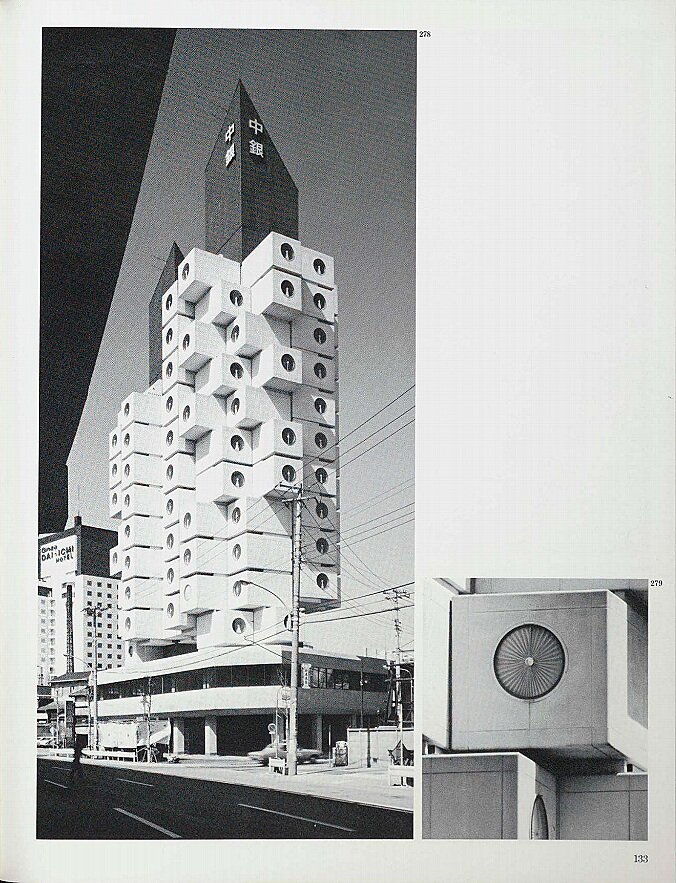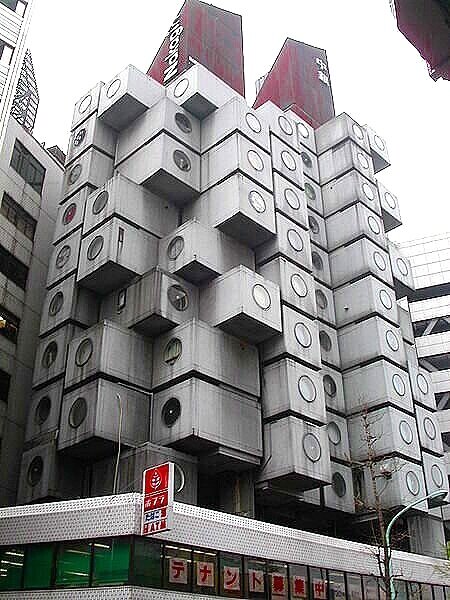The chancery building on Grosvenor Square—a design by Eero Saarinen—was the home of the US embassy in the UK until 2017. This building—which, when it opened in 1960, was a strikingly Modern presence within a traditionally-designed city—was the likely venue for the exhibit on Paul Rudolph which took place in London in the 1960’s.
RUDOLPH’S REPUTATION: INTERNATIONAL
The United States Information Service was an agency under the United States State Department [it was later renamed, and better known as, the United States Information Agency]. Most well-known for their broadcasting efforts (such as the Voice of America, Radio Free Europe, and Radio Liberty), the agency also engaged in a number of other informational and cultural projects, such as setting up libraries of American books in other countries, English language instruction, and exhibitions. Their stated mission was ". . . .to understand, inform and influence foreign publics in promotion of the national interest, and to broaden the dialogue between Americans and U.S. institutions, and their counterparts abroad."
Among the exhibits that the USIS sponsored was one on the work of Paul Rudolph, which was held in the mid-1960's in London. The location would likely have been the American Embassy Chancery Building, which opened in 1960—and was designed by another famous mid-twentieth century Modern architect, Eero Saarinen.
Henry-Russell Hitchcock (1903-1987) was a distinguished and architectural historian—and an advocate for Modern architecture—and the writer of a fascinating text about Paul Rudolph.
HENRY-RUSSELL HITCHCOCK: “DEAN” OF AMERICN ARCHITECTURAL HISTORIANS
The archives of Paul Rudolph Heritage Foundation has a copy of a flyer which was given to visitors who attended that Rudolph exhibit. To our surprise, we find that it was written by Henry-Russell Hitchcock (1903-1987).
Hitchcock was a formidable figure in architectural history—not only as a writer, but also as a teacher, lecturer, and exhibit organizer. His books and articles covered a great range of periods, styles, regions and architects (including one of the first major monographs on Wright). While he is known for his many scholarly historical works, his most famous (and probably most influential) publication was the book The International Style, which was researched and written with Philip Johnson and published in 1932. That book, published by the Museum of Modern Art, (in association with MoMA’s exhibit, “Modern Architecture: International Exhibition”) proclaimed and explained the new mode in architecture to an American audience.
To have an historian of this level of distinction and accomplishment be associated with Rudolph---and writing in such a direct, ‘pull-no-punches’ style---makes this a document of significance.
HITCHCOCK ON PAUL RUDOLPH
Below are excerpts from from the text that was given to visitors to the exhibit.
P A U L R U D O L P H
An exhibition of his architecture
Presented by the United States Information Service
It is not easy to present the architecture of Paul Rudolph to the British. He belongs to a line or group of American modern architects who have never received in England with much enthusiasm. . . .
The characteristic common to Wright, to Saarinen and to Rudolph can be most simply described as brashness, with all the connotations, many of them in England unfavourable, that brashness, implies. Wright and Rudolph, thought not so much Saarinen, have been notable for their brash statements, which often seem to manifest a somewhat juvenile delight in shacking and even offending. In Wright’s case this sort of juvenility was, certainly increased over the years of his 70-year-long public careers, as those who heard him speak on his visit to London a decade or more ago will well remember. But it is, of course, to the brashness of the architecture of these men that I more particularly refer. Brash architecture has not been unknown in Britain. . . . But it is out of favour today in architectural circles, if not in popular music and “pop art”, the very name of which was invented by an English critic before he moved to America.
The early work of Rudolph, the houses built in the late 1940’s and early 50’s in and around Sarasota, Florida, in association with the local well-established architect Ralph Twitchell, were not only calm and disciplined in their design, which was definitely by Rudolph and not by Twitchell. If they are far less American than, for example, Saarinen’s General Motors Technical Institute in Michigan or Johnson’s houses in Connecticut of these years, they none-the-less have a severity of outline and a stripped frankness of structural expression that contrasts somewhat with the Wrightian openness of the planning and their adaptation, visually and functionally, to the flat coastal scenery of the Keys, along the Gulf of Mexico with their damp climate and their exposures to such serious local plagues as insect hordes and annual hurricanes.
“He is, above all, in his failures and even more than in his successes, in his parking garages and his pharmaceutical plants as much as in his representational art buildings, an artist in architecture, concerned to dispose his spaces, to model his masses, to choose and treat his materials, as great architects have always done, in such a way as to achieve compositions, works of art, that are only possible to architectural scale. ”
Rudolph’s apprentice years beginning after his war-time service in the Navy, though less confined to a single line-than Wright’s with his “Lieber Meister” Sullivan, of Saarinen in the process of freeing himself from his father by a rather literal acceptance of the American discipline, were even more single-minded and self-consistent. But he was, of course, older than Wright had been in his eclectic period in the 1890’s and had no Oedipal problem such as Saarinen’s.
Brash architects are to some extent gamblers: the sure fling soon ceases to interest them, so they must always be trying a more difficult throw of the dice or combination of the horses. But like professional gamblers, if the architects in question are trained and experienced professionals and not amateurs, the proportion and the size of their wins increases until the artistic profit overshadows the more comfortable earnings of the ploddingly respectable. (It should be noted, however, that this may well apply in reverse to their respective financial rewards!) In Eero Saarinen’s case almost every new try was happily a success in his last years and all different from one another. The Yale Colleges, the Dulles Airport and the Deere Plow offices certainly more than offset the very debatable TWA building at the Kennedy Airport.
The Married Students Quarters, piled up in cubes like the towns on islands in the Aegean, has been especially influential with Yale students. To English critics it has usually, however, been offensive, because the brickwork is not “honestly” structural, but a mere veneer over wooden construction providing in a long-familiar American vernacular way a permanent weatherproof sheathing as tile-hanging frequently does in England. The parking-garage is one of the most successful of innumerable attempts since Mendelsohn’s Einstein Tower of 40 years ago to exploit concrete—in this case left raw—as a plastic or sculptural material in contrast to the more usual American expression as rectangular post-and-lintel construction.
The Art and Architecture Building, to judge from the latest to be completed of Rudolph’s buildings, that for the Endo Pharmaceutical Company at Garden City outside New York, and the project for the very large administrative building for the State of Massachusetts, occupying a considerable area adjacent to the new governmental centre in Boston (in association with the long-established local firm of Shepley, Richardson, Bulfinch and Abbott, professional heirs an actual descendants of H. H. Richardson) suggests that the gambler has, indeed, found the formula that assures a high proportion of wins, that the wheel has come a full circle, now that the modest beginner who designed the Sarasota houses has reached full maturity and can profit from all the varied experiments he has had along the road.
He is, above all, in his failures and even more than in his successes, in his parking garages and his pharmaceutical plants as much as in his representational art buildings, an artist in architecture, concerned to dispose his spaces, to model his masses, to choose and treat his materials, as great architects have always done, in such a way as to achieve compositions, works of art, that are only possible to architectural scale.
No painter, as Le Corbusier has been throughout his career, no sculptor as Saarinen was before he turned to architecture, no theorist like Gropius though an active educator, he is one of several Americans who are attempting to prove, who on occasion in the last few years have proved, to most of those who were not prejudiced by a priori pseudo-historical considerations, that architecture can still be an art as well as technological process for solving problems of shelter.
THE COMPLETE HITCHCOCK TEXT
The full text of Henry-Russell Hitchcock’s exhibition essay can be found at the Paul Rudolph Heritage Foundation’s ARTICLES & WRITINGS page (which has a large collection of written resources on and by Rudolph)—and a direct link to the Hitchcock text is here.
Hitchcock himself is well worth study, and—though a full biography has yet to be published—Helen Searing has written insightful essays on him, particularly “Henry-Russell Hitchcock: The Architectural Historian as Critic and Connoisseur.” She has also edited a tribute volume to him, and contributed to an anthology of papers which focuses on the work of Hitchcock and his almost exact contemporary: architectural historian John Summerson of Britain.
ABOVE: a tribute volume to Hitchcock, which has essays that are about him. or which resonate with topics in which he was interested. It can be read, on-line, here. LEFT: an anthology of papers on Hitchcock and John Summerson—a contemporary (and equally distinguished) architectural historian from Britain. It can be read, on-line, here.
IMAGE CREDITS
NOTES:
The Paul Rudolph Heritage Foundation gratefully thanks all the individuals and organizations whose images are used in this non-profit scholarly and educational project.
The credits are shown when known to us, and are to the best of our knowledge, but the origin and connected rights of many images (especially vintage photos and other vintage materials) are often difficult determine. In all cases the materials are used in-good faith, and in fair use, in our non-profit, scholarly, and educational efforts. If any use, credits, or rights need to be amended or changed, please let us know.
When/If Wikimedia Commons links are provided, they are linked to the information page for that particular image. Information about the rights for the use of each of those images, as well as technical information on the images, can be found on those individual pages.
CREDITS, FROM TOP-TO-BOTTOM, AND LEFT-TO-RIGHT:
Former American Embassy Building, in London: photo by Ian S, via Wikimedia Commons; United States Information Service Emblem: US government graphic, courtesy of the National Museum of Diplomacy, US State Department; Henry-Russell Hitchcock, vintage profile photo: circa 1930’s, via the Archives of American Art; Cover of “Summerson and Hitchcock”: from the Amazon page for that book; Cover of “In Search of Modern Architecture": from the Amazon page for that book.





















































